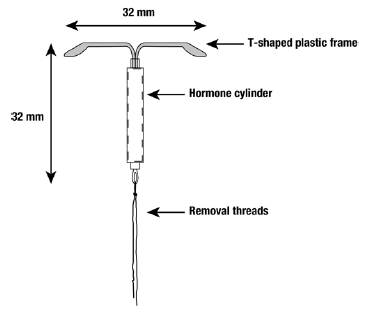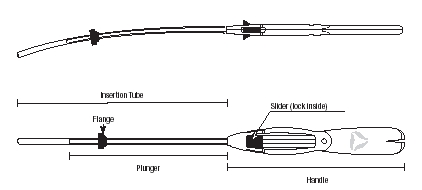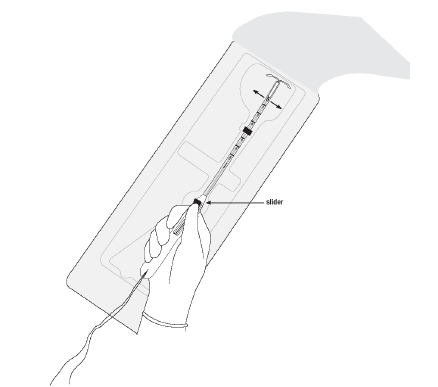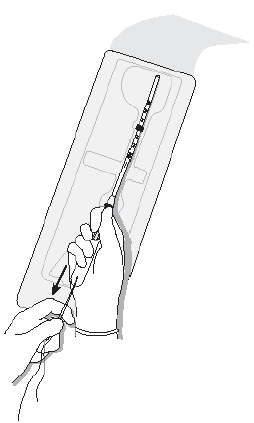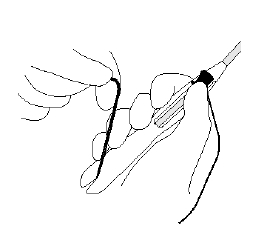| MIRENA - levonorgestrel intrauterine device Bayer HealthCare Pharmaceuticals Inc. MIRENA® (levonorgestrel-releasing intrauterine system) PATIENTS SHOULD BE COUNSELED THAT THIS PRODUCT DOES NOT PROTECT AGAINST HIV INFECTION (AIDS) AND OTHER SEXUALLY TRANSMITTED DISEASES Rx only DESCRIPTIONMirena® (levonorgestrel-releasing intrauterine system) consists of a T-shaped polyethylene frame (T-body) with a steroid reservoir (hormone elastomer core) around the vertical stem. The reservoir consists of a white or almost white cylinder, made of a mixture of levonorgestrel and silicone (polydimethylsiloxane), containing a total of 52 mg levonorgestrel. The reservoir is covered by a semi-opaque silicone (polydimethylsiloxane) membrane. The T-body is 32 mm in both the horizontal and vertical directions. The polyethylene of the T-body is compounded with barium sulfate, which makes it radiopaque. A monofilament brown polyethylene removal thread is attached to a loop at the end of the vertical stem of the T-body.
Schematic drawing of Mirena
InserterMirena is packaged sterile within an inserter. The inserter, which is used for insertion of Mirena into the uterine cavity, consists of a symmetric two-sided body and slider that are integrated with flange, lock, pre-bent insertion tube and plunger. Once Mirena is in place, the inserter is discarded.
Diagram of Inserter
Mirena is intended to provide an initial release rate of 20 μg/day of levonorgestrel. Levonorgestrel USP, (-)-13-Ethyl-17-hydroxy-18,19-dinor-17α-pregn-4-en-20-yn-3-one, the active ingredient in Mirena, has a molecular weight of 312.4, a molecular formula of C21H28O2, and the following structural formula: 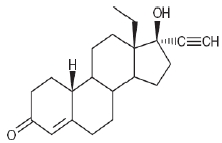 CLINICAL PHARMACOLOGYLevonorgestrel is a progestogen used in a variety of contraceptive products. Low doses of levonorgestrel can be administered into the uterine cavity with the Mirena intrauterine delivery system. Initially, levonorgestrel is released at a rate of approximately 20 μg/day. This rate decreases progressively to half that value after 5 years. Mirena has mainly local progestogenic effects in the uterine cavity. Morphological changes of the endometrium are observed, including stromal pseudodecidualization, glandular atrophy, a leukocytic infiltration and a decrease in glandular and stromal mitoses. Ovulation is inhibited in some women using Mirena. In a 1-year study approximately 45% of menstrual cycles were ovulatory and in another study after 4 years 75% of cycles were ovulatory. The local mechanism by which continuously released levonorgestrel enhances contraceptive effectiveness of Mirena has not been conclusively demonstrated. Studies of Mirena prototypes have suggested several mechanisms that prevent pregnancy: thickening of cervical mucus preventing passage of sperm into the uterus, inhibition of sperm capacitation or survival, and alteration of the endometrium. Clinical PharmacokineticsFollowing insertion of Mirena, the initial release of levonorgestrel into the uterine cavity is 20 μg/day. A stable plasma level of levonorgestrel of 150-200 pg/mL occurs after the first few weeks following insertion of Mirena. Levonorgestrel levels after long-term use of 12, 24, and 60 months were 180±66 pg/mL, 192±140 pg/mL, and 159±59 pg/mL, respectively. The plasma concentrations achieved by Mirena are lower than those seen with levonorgestrel contraceptive implants and with oral contraceptives. Unlike oral contraceptives, plasma levels with Mirena do not display peaks and troughs. The mean ± SD levonorgestrel endometrial tissue concentration in four women using levonorgestrel intrauterine systems releasing 30 μg/day of levonorgestrel for 36-49 days was 808 ± 511 ng/g wet tissue weight. The endometrial tissue concentration in 2 women who had been taking a 250 μg levonorgestrel–containing oral contraceptive for 7 days was 3.5 ng/g wet tissue weight. In contrast, fallopian tube and myometrial levonorgestrel tissue concentrations were of the same order of magnitude in the Mirena group and the oral contraceptive group (between 1 and 5 ng/g of wet weight of tissue). The pharmacokinetics of levonorgestrel itself have been extensively studied and reported in the literature. Levonorgestrel in serum is primarily bound to proteins (mainly sex hormone binding globulin) and is extensively metabolized to a large number of inactive metabolites. Metabolic clearance rates may differ among individuals by several-fold, and this may account in part for wide individual variations in levonorgestrel concentrations seen in individuals using levonorgestrel–containing contraceptive products. The elimination half-life of levonorgestrel after daily oral doses is approximately 17 hours; both the parent drug and its metabolites are primarily excreted in the urine. Pharmacokinetic studies of this product have not been conducted in special populations (pediatric, renal insufficiency, hepatic insufficiency, and different ethnic groups). Drug-Drug InteractionsThe effect of other drugs on the efficacy of Mirena has not been studied. INDICATIONS AND USAGEMirena is indicated for intrauterine contraception for up to 5 years. Thereafter, if continued contraception is desired, the system should be replaced. Mirena is recommended for women who have had at least one child. CLINICAL STUDIESMirena has been studied for safety and efficacy in two large clinical trials in Finland and Sweden. In study sites having verifiable data and informed consent, 1169 women 18 to 35 years of age at enrollment used Mirena for up to 5 years, for a total of 45,000 women-months of exposure. Subjects had previously been pregnant, had no history of ectopic pregnancy, had no history of pelvic inflammatory disease over the preceding 12 months, were predominantly Caucasian, and over 70% of the participants had previously used IUDs (intrauterine devices). The reported 12-month pregnancy rates were less than or equal to 0.2 per 100 women and the cumulative 5-year pregnancy rate was approximately 0.7 per 100 women. However, due to limitations of the available data a precise estimate of the pregnancy rate is not possible. CONTRAINDICATIONSMirena is contraindicated when one or more of the following conditions exist:
WARNINGS1. Ectopic PregnancyEvaluate women who become pregnant while using Mirena for ectopic pregnancy. Up to half of pregnancies that occur with Mirena in place are ectopic. The incidence of ectopic pregnancy in clinical trials that excluded women with risk factors for ectopic pregnancy was about 1 ectopic pregnancy per 1000 users per year. Tell women who choose Mirena about the risks of ectopic pregnancy, including the loss of fertility. Teach them to recognize and report to their physician promptly any symptoms of ectopic pregnancy. Women with a previous history of ectopic pregnancy, tubal surgery or pelvic infection carry a higher risk of ectopic pregnancy. The risk of ectopic pregnancy in women who have a history of ectopic pregnancy and use Mirena is unknown. Clinical trials of Mirena excluded women with a history of ectopic pregnancy. 2. Intrauterine PregnancyIf pregnancy should occur with Mirena in place, Mirena should be removed. Removal or manipulation of Mirena may result in pregnancy loss. In the event of an intrauterine pregnancy with Mirena, consider the following: a. Septic abortionIn patients becoming pregnant with an IUD in place, septic abortion—with septicemia, septic shock, and death—may occur. b. Continuation of pregnancyIf a woman becomes pregnant with Mirena in place and if Mirena cannot be removed or the woman chooses not to have it removed, she should be warned that failure to remove Mirena increases the risk of miscarriage, sepsis, premature labor and premature delivery. She should be followed closely and advised to report immediately any flu-like symptoms, fever, chills, cramping, pain, bleeding, vaginal discharge or leakage of fluid. c. Long-term effects and congenital anomaliesWhen pregnancy continues with Mirena in place, long-term effects on the offspring are unknown. As of September 2006, 390 live births out of an estimated 9.9 million Mirena users had been reported. Congenital anomalies in live births have occurred infrequently. No clear trend towards specific anomalies has been observed. Because of the intrauterine administration of levonorgestrel and local exposure of the fetus to the hormone, the possibility of teratogenicity following exposure to Mirena cannot be completely excluded. Some observational data support a small increased risk of masculinization of the external genitalia of the female fetus following exposure to progestins at doses greater than those currently used for oral contraception. Whether these data apply to Mirena is unknown. 3. SepsisAs of September 2006, 9 cases of Group A streptococcal sepsis (GAS) out of an estimated 9.9 million Mirena users had been reported. In some cases, severe pain occurred within hours of insertion followed by sepsis within days. Because death from GAS is more likely if treatment is delayed, it is important to be aware of these rare but serious infections. Aseptic technique during insertion of Mirena is essential. GAS sepsis may also occur postpartum, after surgery, and from wounds. 4. Pelvic Inflammatory Disease (PID)Mirena is contraindicated in the presence of known or suspected PID or in women with a history of PID unless there has been a subsequent intrauterine pregnancy. Use of IUDs has been associated with an increased risk of PID. The highest risk of PID occurs shortly after insertion (usually within the first 20 days thereafter) (see PRECAUTIONS, Insertion Precautions). A decision to use Mirena must include consideration of the risks of PID. a. Women at increased risk for PIDPID is often associated with a sexually transmitted disease, and Mirena does not protect against sexually transmitted disease. The risk of PID is greater for women who have multiple sexual partners, and also for women whose sexual partner(s) have multiple sexual partners. Women who have had PID are at increased risk for a recurrence or re-infection. b. PID warning to Mirena usersAll women who choose Mirena must be informed prior to insertion about the possibility of PID and that PID can cause tubal damage leading to ectopic pregnancy or infertility, or infrequently can necessitate hysterectomy, or cause death. Patients must be taught to recognize and report to their physician promptly any symptoms of pelvic inflammatory disease. These symptoms include development of menstrual disorders (prolonged or heavy bleeding), unusual vaginal discharge, abdominal or pelvic pain or tenderness, dyspareunia, chills, and fever. c. Asymptomatic PIDPID may be asymptomatic but still result in tubal damage and its sequelae. d. Treatment of PIDFollowing a diagnosis of PID, or suspected PID, bacteriologic specimens should be obtained and antibiotic therapy should be initiated promptly. Removal of Mirena after initiation of antibiotic therapy is usually appropriate. Guidelines for PID treatment are available from the Centers for Disease Control (CDC), Atlanta, Georgia. Actinomycosis has been associated with IUDs. Symptomatic women with IUDs should have the IUD removed and should receive antibiotics. However, the management of the asymptomatic carrier is controversial because actinomycetes can be found normally in the genital tract cultures in healthy women without IUDs. False positive findings of actinomycosis on Pap smears can be a problem. When possible, confirm the Pap smear diagnosis with cultures. 5. Irregular Bleeding and AmenorrheaMirena can alter the bleeding pattern and result in spotting, irregular bleeding, heavy bleeding, oligomenorrhea and amenorrhea. During the first three to six months of Mirena use, the number of bleeding and spotting days may be increased and bleeding patterns may be irregular. Thereafter the number of bleeding and spotting days usually decreases but bleeding may remain irregular. If bleeding irregularities develop during prolonged treatment, appropriate diagnostic measures should be taken to rule out endometrial pathology. Amenorrhea develops in approximately 20% of Mirena users by one year. The possibility of pregnancy should be considered if menstruation does not occur within six weeks of the onset of previous menstruation. Once pregnancy has been excluded, repeated pregnancy tests are generally not necessary in amenorrheic women unless indicated, for example, by other signs of pregnancy or by pelvic pain. 6. EmbedmentEmbedment of Mirena in the myometrium may occur. Embedment may decrease contraceptive effectiveness and result in pregnancy (see WARNINGS,Ectopic Pregnancy and Intrauterine Pregnancy). An embedded Mirena should be removed. Embedment can result in difficult removal and, in some cases surgical removal may be necessary. 7. PerforationPerforation or penetration of the uterine wall or cervix may occur during insertion although the perforation may not be detected until some time later. If perforation occurs, pregnancy may result (see WARNINGS, Ectopic Pregnancy and Intrauterine Pregnancy). Mirena must be located and removed; surgery may be required. Delayed detection of perforation may result in migration outside the uterine cavity, adhesions, peritonitis, intestinal perforations, intestinal obstruction, abscesses and erosion of adjacent viscera. The risk of perforation may be increased in lactating women, in women with fixed retroverted uteri, and during the postpartum period. To decrease the risk of perforation postpartum, Mirena insertion should be delayed a minimum of 6 weeks after delivery or until uterine involution is complete. If involution is substantially delayed, consider waiting until 12 weeks postpartum. Inserting Mirena immediately after first trimester abortion is not known to increase the risk of perforation, but insertion after second trimester abortion should be delayed until uterine involution is complete. 8. ExpulsionPartial or complete expulsion of Mirena may occur (see PRECAUTIONS, Continuation and Removal). Symptoms of the partial or complete expulsion of any lUD may include bleeding or pain. However, the system can be expelled from the uterine cavity without the woman noticing it. Partial expulsion may decrease the effectiveness of Mirena. As menstrual flow typically decreases after the first 3 to 6 months of Mirena use, an increase of menstrual flow may be indicative of an expulsion. If expulsion has occurred, Mirena may be replaced within 7 days of a menstrual period after pregnancy has been ruled out. 9. Ovarian CystsSince the contraceptive effect of Mirena is mainly due to its local effect, ovulatory cycles with follicular rupture usually occur in women of fertile age using Mirena. Sometimes atresia of the follicle is delayed and the follicle may continue to grow. Enlarged follicles have been diagnosed in about 12% of the subjects using Mirena. Most of these follicles are asymptomatic, although some may be accompanied by pelvic pain or dyspareunia. In most cases the enlarged follicles disappear spontaneously during two to three months observation. Persistent enlarged follicles should be evaluated. Surgical intervention is not usually required. 10. Breast CancerWomen who currently have or have had breast cancer, or have a suspicion of breast cancer, should not use hormonal contraception because breast cancer is a hormone-sensitive tumor. Spontaneous reports of breast cancer have been received during post marketing experience with Mirena. Because spontaneous reports are voluntary and from a population of uncertain size, it is not possible to use post-marketing data to reliably estimate the frequency or establish causal relationship to drug exposure. Two observational studies have not provided evidence of an increased risk of breast cancer during the use of Mirena. 11. Risks of MortalityThe available data from a variety of sources have been analyzed to estimate the risk of death associated with various methods of contraception. These estimates include the combined risk of the contraceptive method plus the risk of pregnancy or abortion in the event of method failure. The findings of the analysis are shown in Table 1.
PRECAUTIONSPATIENTS SHOULD BE COUNSELED THAT THIS PRODUCT DOES NOT PROTECT AGAINST HIV INFECTION (AIDS) AND OTHER SEXUALLY TRANSMITTED DISEASES. 1. Patient Counseling InformationPrior to insertion, give the patient the Patient Information Booklet. She should be given the opportunity to read the information and discuss fully any questions she may have concerning Mirena as well as other methods of contraception. Also, advise the patient that the prescribing information is available to her upon request. Careful and objective counseling of the patient prior to insertion regarding the expected bleeding pattern, the possible inter-individual variation in changes in bleeding, including amenorrhea, and the etiology of the changes may have an effect on the frequency of patient-requested removal. The patient should be informed that some bleeding such as irregular or prolonged bleeding and spotting, and/or cramps may occur during the first few weeks after insertion. If her symptoms continue or are severe she should report them to her health care provider. She should also be given instructions on what other symptoms require her to call her health care provider. She should be instructed on how to check after her menstrual period to make certain that the threads still protrude from the cervix and cautioned not to pull on the threads and displace Mirena. She should be informed that there is no contraceptive protection if Mirena is displaced or expelled. 2. Patient Evaluation and Clinical Considerationsa. A complete medical and social history, including that of the partner, should be obtained to determine conditions that might influence the selection of an IUD for contraception (see CONTRAINDICATIONS). b. A physical examination should include a pelvic examination, a Pap smear, examination of the breasts, and appropriate tests for any other forms of genital or other sexually transmitted diseases, such as gonorrhea and chlamydia laboratory evaluations, if indicated. Use of Mirena in patients with vaginitis or cervicitis should be postponed until proper treatment has eradicated the infection and until it has been shown that the cervicitis is not due to gonorrhea or chlamydia (see CONTRAINDICATIONS). c. Irregular bleeding may mask symptoms and signs of endometrial polyps or cancer. Because irregular bleeding/spotting is common during the first months of Mirena use, exclude endometrial pathology prior to the insertion of Mirena in women with persistent or uncharacteristic bleeding. If unexplained bleeding irregularities develop during the prolonged use of Mirena, appropriate diagnostic measures should be taken. (See WARNINGS, Irregular Bleeding and Amenorrhea.) d. The health care provider should determine that the patient is not pregnant. The possibility of insertion of Mirena in the presence of an existing undetermined pregnancy is reduced if insertion is performed within 7 days of the onset of a menstrual period. Mirena can be replaced by a new system at any time in the cycle. Mirena can be inserted immediately after first trimester abortion. e. Mirena should not be inserted until 6 weeks postpartum or until involution of the uterus is complete in order to reduce the incidence of perforation and expulsion. If involution is substantially delayed, consider waiting until 12 weeks postpartum (see WARNINGS, Perforation). f. Patients with certain types of valvular or congenital heart disease and surgically constructed systemic-pulmonary shunts are at increased risk of infective endocarditis. Use of Mirena in these patients may represent a potential source of septic emboli. Patients with known congenital heart disease who may be at increased risk should be treated with appropriate antibiotics at the time of insertion and removal. g. Patients requiring chronic corticosteroid therapy or insulin for diabetes should be monitored with special care for infection. h. Mirena should be used with caution in patients who have:
3. Insertion Precautionsa. Observe strict asepsis during insertion. The presence of organisms capable of establishing PID cannot be determined by appearance, and IUD insertion may be associated with introduction of vaginal bacteria into the uterus. Administration of antibiotics may be considered, but the utility of this treatment is unknown. b. Carefully sound the uterus prior to Mirena insertion to determine the degree of patency of the endocervical canal and the internal os, and the direction and depth of the uterine cavity. In occasional cases, severe cervical stenosis may be encountered. Do not use excessive force to overcome this resistance. c. Fundal positioning of Mirena is important to prevent expulsion and maximize efficacy. Therefore, follow the instructions for the insertion carefully. d. If the patient develops decreased pulse, perspiration, or pallor, have her remain supine until these signs resolve. Insertion may be associated with some pain and/or bleeding. Syncope, bradycardia, or other neurovascular episodes may occur during insertion of Mirena, especially in patients with a predisposition to these conditions or cervical stenosis. 4. Continuation and Removala. Reexamine and evaluate patients 4 to 12 weeks after insertion and once a year thereafter, or more frequently if clinically indicated. b. If the threads are not visible, they may have retracted into the uterus or broken, or Mirena may have broken, perforated the uterus, or been expelled (see WARNINGS, Perforation and Expulsion). If the length of the threads has changed from the length at time of insertion, the system may have become displaced. Pregnancy must be excluded and the location of Mirena verified, for example, by sonography, X-ray, or by gentle exploration of the uterine cavity with a probe. If Mirena is displaced, remove it. A new Mirena may be inserted at that time or during the next menses if it is certain that conception has not occurred. If Mirena is in place with no evidence of perforation, no intervention is indicated. c. Promptly examine users with complaints of pain, odorous discharge, unexplained bleeding (see WARNINGS, Irregular Bleeding and Amenorrhea), fever, genital lesions or sores. d. Consider the possibility of ectopic pregnancy in the case of lower abdominal pain especially in association with missed periods or if an amenorrheic woman starts bleeding (see WARNINGS, Ectopic Pregnancy). e. In the event a pregnancy is confirmed during Mirena use:
f. Should the patient's relationship cease to be mutually monogamous, or should her partner become HIV positive, or acquire a sexually transmitted disease, she should be instructed to report this change to her clinician immediately. The use of a barrier method as a partial protection against acquiring sexually transmitted diseases should be strongly recommended. Removal of Mirena should be considered. g. Mirena should be removed for the following medical reasons:
h. Removal of the system should also be considered if any of the following conditions arise for the first time:
i. Removal may be associated with pain and/or bleeding or neurovascular episodes. 5. Glucose ToleranceLevonorgestrel may affect glucose tolerance, and the blood glucose concentration should be monitored in diabetic users of Mirena. 6. Drug InteractionsThe influence of drugs on the contraceptive efficacy of Mirena has not been studied. The metabolism of progestogens may be increased by concomitant use of substances known to induce drug-metabolizing liver enzymes, specifically cytochrome P450 enzymes. 7. CarcinogenesisLong-term studies in animals to assess the carcinogenic potential of levonorgestrel releasing intrauterine system have not been performed (see WARNINGS). 8. PregnancyPregnancy Category X(see WARNINGS). 9. Nursing MothersIn general, no adverse effects have been found on breastfeeding performance or on the health, growth, or development of the infant. However, isolated post-marketing cases of decreased milk production have been reported. Small amounts of progestins pass into the breast milk of nursing mothers, resulting in detectable steroid levels in infant plasma. Also, see WARNINGS, Perforation. 10. Pediatric UseSafety and efficacy of Mirena have been established in women of reproductive age. Use of this product before menarche is not indicated. 11. Geriatric UseMirena has not been studied in women over age 65 and is not currently approved for use in this population. 12. Return to FertilityAbout 80% of women wishing to become pregnant conceived within 12 months after removal of Mirena. ADVERSE REACTIONSThe most serious adverse reactions associated with the use of Mirena are discussed above in the WARNINGS and PRECAUTIONS sections. Very common adverse reactions (>1/10 users) include uterine/vaginal bleeding (including spotting, irregular bleeding, heavy bleeding, oligomenorrhea and amenorrhea) and ovarian cysts. Other adverse events are listed below using MedDRA (9.0) terms. Adverse reactions reported by 5% or more of clinical trial subjects include: Abdominal/pelvic pain Vaginal discharge Nausea Headache Nervousness Vulvovaginitis Dysmenorrhea Back pain Weight increase Breast pain/tenderness Acne Decreased libido Depressed mood Cervicitis/Papanicolaou smear normal, class II Hypertension Other relevant reported adverse reactions occurring in less than 5% of subjects include: migraine, vomiting, anemia, dyspareunia, alopecia, eczema, pruritis, rash, urticaria, abdominal distension, altered mood, hirsutism, edema. Postmarketing ExperienceThe following adverse reactions have been identified during post approval use of Mirena: device breakage and angioedema. Because these reactions are reported voluntarily from a population of uncertain size, it is not always possible to reliably estimate their frequency or establish a causal relationship to drug exposure. DOSAGE AND ADMINISTRATIONMirena contains 52 mg of levonorgestrel. Initially, levonorgestrel is released at a rate of approximately 20 μg/day. This rate decreases progressively to half that value after 5 years. Mirena is indicated for intrauterine contraception for up to 5 years. Thereafter, if continued contraception is desired, the system should be replaced. Mirena is packaged sterile within an inserter. Information regarding insertion instructions, patient counseling and record keeping, patient follow-up, removal of Mirena and continuation of contraception after removal is provided below. 1. Insertion InstructionsNOTE: Mirena should be inserted by a trained health care provider. Health care providers are advised to become thoroughly familiar with the insertion instructions before attempting insertion of Mirena. Mirena is inserted with the provided inserter (Figure 1a) into the uterine cavity within seven days of the onset of menstruation or immediately after first trimester abortion by carefully following the insertion instructions. It can be replaced by a new Mirena at any time during the menstrual cycle.
Figure 1a. Mirena and inserter
a. Preparation for insertion
b. Insertion ProcedureNOTE: Ensure use of sterile technique throughout the entire procedure. Step 1 Opening of the sterile package
Figure 1b. Aligning the arms with the slider in the furthest position
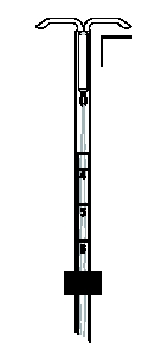 Figure 1c. Checking that the arms are horizontal and aligned with respect to the scale Step 2 Load Mirena into the insertion tube
Figure 2a. Loading Mirena into the insertion tube
 Figure 2b. Properly loaded Mirena with knobs closing the end of the insertion tube Step 3 Secure the threads
Figure 3. Threads are secured in the cleft Step 4 Setting the flange

Figure 4. Setting the flange to the uterine depth Step 5 Mirena is now ready to be inserted
NOTE! Do not force the inserter. If necessary, dilate the cervical canal. 
Figure 5. Advancing insertion tube until flange is 1.5 to 2 cm from cervical os Step 6 Release the arms

Figure 6a. Pulling the slider back to reach the mark 
Figure 6b. Releasing the arms of Mirena Step 7 Advance to fundal position

Figure 7. Mirena in the fundal position Step 8 Release Mirena and withdraw the inserter

Figure 8. Releasing Mirena from the insertion tube Step 9 Cut the threads

Figure 9. Cutting the threads Mirena insertion is now complete. IMPORTANT!
2. Patient Counseling and Record Keeping
3. Patient Follow-up
4. Removal of Mirena
IMPORTANT!
5. Continuation of Contraception After Removal
HOW SUPPLIEDMirena (levonorgestrel-releasing intrauterine system), containing a total of 52 mg levonorgestrel, is available in a carton of one sterile unit NDC# 50419-421-01. Each Mirena is packaged together with an inserter in a thermoformed blister package with a peelable lid. Mirena is supplied sterile. Mirena is sterilized with ethylene oxide. Do not resterilize. For single use only. Do not use if the inner package is damaged or open. Insert before the end of the month shown on the label. STORAGE AND HANDLINGStore at 25°C (77°F); with excursions permitted between 15-30°C (59-86°F) [See USP Controlled Room Temperature]. | ||||||||||||||||||||||||||||||||||||||||||||||||||||||||||||||||||||||||||||||||||||||||||||||||||||||||||||||||


